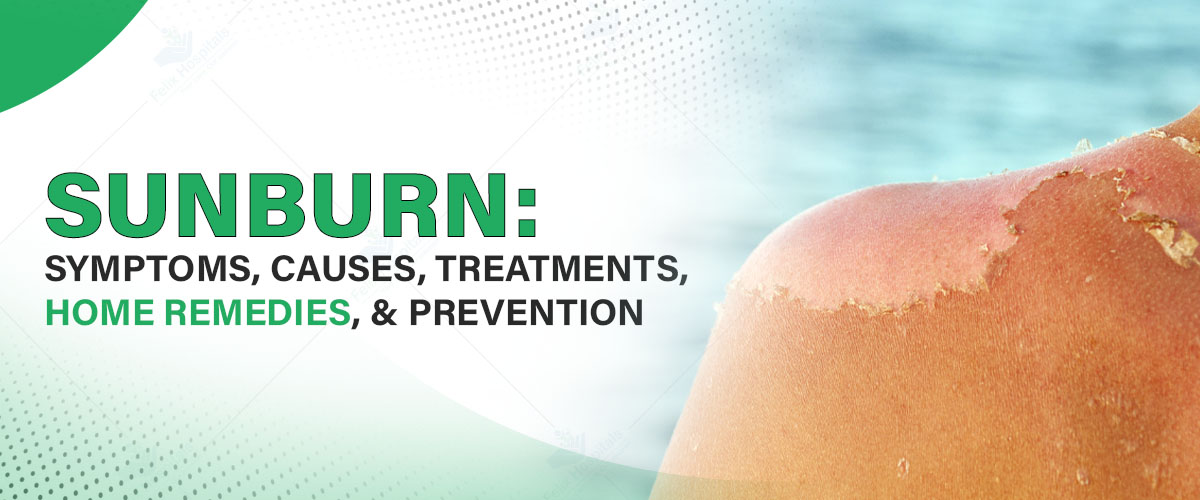
Subscribe to our

We need sunlight to stay healthy, but too much of it, especially without protection, can hurt our skin. The body naturally reacts to too much ultraviolet (UV) radiation by being sunburned. People often think of sunburn as being "red skin," but it can cause anything from slight discomfort to significant blisters and long-term skin damage.
It's vital to know the different kinds and levels of severity of sunburn so you can do the correct thing, whether that means taking care of it at home or going to the doctor.
This blog post covers the types of sunburn, how to tell them apart, and how to heal quickly and safely.
If you have persistent skin problems or complications such as sunburn or rashes, visit a skin care hospital in Noida for expert diagnosis and personalized treatment.
Call us now at +91 9667064100 for the best dermatologist consultation in the best hospital of Noida.
Sunburn is the skin's reaction to too much ultraviolet (UV) light. UV rays hurt and kill skin cells when they get through the outer layer of your skin (epidermis). In response, the body sends more blood to the area that was burned, which causes the usual indicators of sunburn: redness, discomfort, warmth, and sometimes swelling.
People often think that sunburn only happens at the beach. You can become burnt when
Even a short amount of time in the sun without protection can hurt your skin, especially during the hottest parts of the day.
1. First-Degree Sunburn
2. Second-Degree Sunburn
3. Third-Degree Sunburn
Symptoms of sunburn often do not appear right after being in the sun. Usually, symptoms like redness, pain, and warmth show up a few hours after exposure and worsen over the next 24 hours.
Symptoms:
Rarely, symptoms of dehydration or sunstroke accompany sunburn and require treatment.
When your skin is exposed to too much ultraviolet (UV) radiation, either from the sun or from artificial sources like tanning beds, you suffer sunburn. Too much exposure hurts the skin cells, which causes inflammation, discomfort, redness, and peeling.
You can usually heal a light sunburn at home with simple therapies. If you have severe burns, intense erythema, or blisters, it is advisable to visit the best skin doctor in Noida.
While most sunburns are mild and may be managed at home, certain signs may indicate a more serious condition requiring medical attention. We recommend consulting a dermatologist for skin treatment in Noida if you experience any of these concerning symptoms.
These signs suggest that the skin injury may be more severe or complicated by infection. Consulting a qualified dermatologist ensures proper wound care, requisite prescription treatments, and professional guidance for swift and safe recovery.
Anyone can get sunburned, but several factors can increase the likelihood. Knowing these can help you take better care of your skin and keep it safe.
Knowing these risk factors can help you safeguard yourself.
Avoiding sunburn is considerably easier than dealing with it afterward. Here are some great methods for protecting your skin:
Schedule your appointment with the top dermatologist at the top hospital for your better understanding.
Your skin safeguards your body, so it is logical to reciprocate that protection. Several fundamental measures can be implemented to prevent, address, and manage sunburn. Maintaining your skin can prevent discomfort today and avert issues in the future, regardless of whether you are engaged in outdoor activities or routine tasks.
Q: Can I get sunburned on a cloudy day or during the winter?
Ans: Yes. Clouds can block up to 80% of UV rays, but snow and water can reflect them, increasing exposure.
Q: Can dark-skinned individuals get sunburned?
Ans: Yes. People with darker skin can still get sunburned, even though redness is less visible. The signs include pain, peeling, or black spots on the skin. All skin types need protection from ultraviolet light.
Q: Is daily sunscreen application sufficient to provide all-day UV protection?
Ans: No. You need to put on sunscreen again every two hours, or more often if you're swimming, sweating, or drying off with a towel. Reapplying makes sure you stay protected all day.
Q: Can I use makeup or skincare products on sunburn?
Ans: Don't use makeup or products that have alcohol, retinoids. Use moisturizers that are gentle and don't have any scents, and talk to a doctor about safe alternatives.
Q: What products should be avoided after a sunburn?
Ans: Avoid petroleum jelly, alcoholic goods, and heavy ointments. Stick with calming substances like aloe vera.
Q: Do sunburns leave scars?
Ans: Mild burns rarely leave scars. Burns that are severe or infected can leave scars or discolouration.